Palliative Care Practice Case Study 2022
VerifiedAdded on 2022/10/04
|8
|1793
|19
AI Summary
Contribute Materials
Your contribution can guide someone’s learning journey. Share your
documents today.
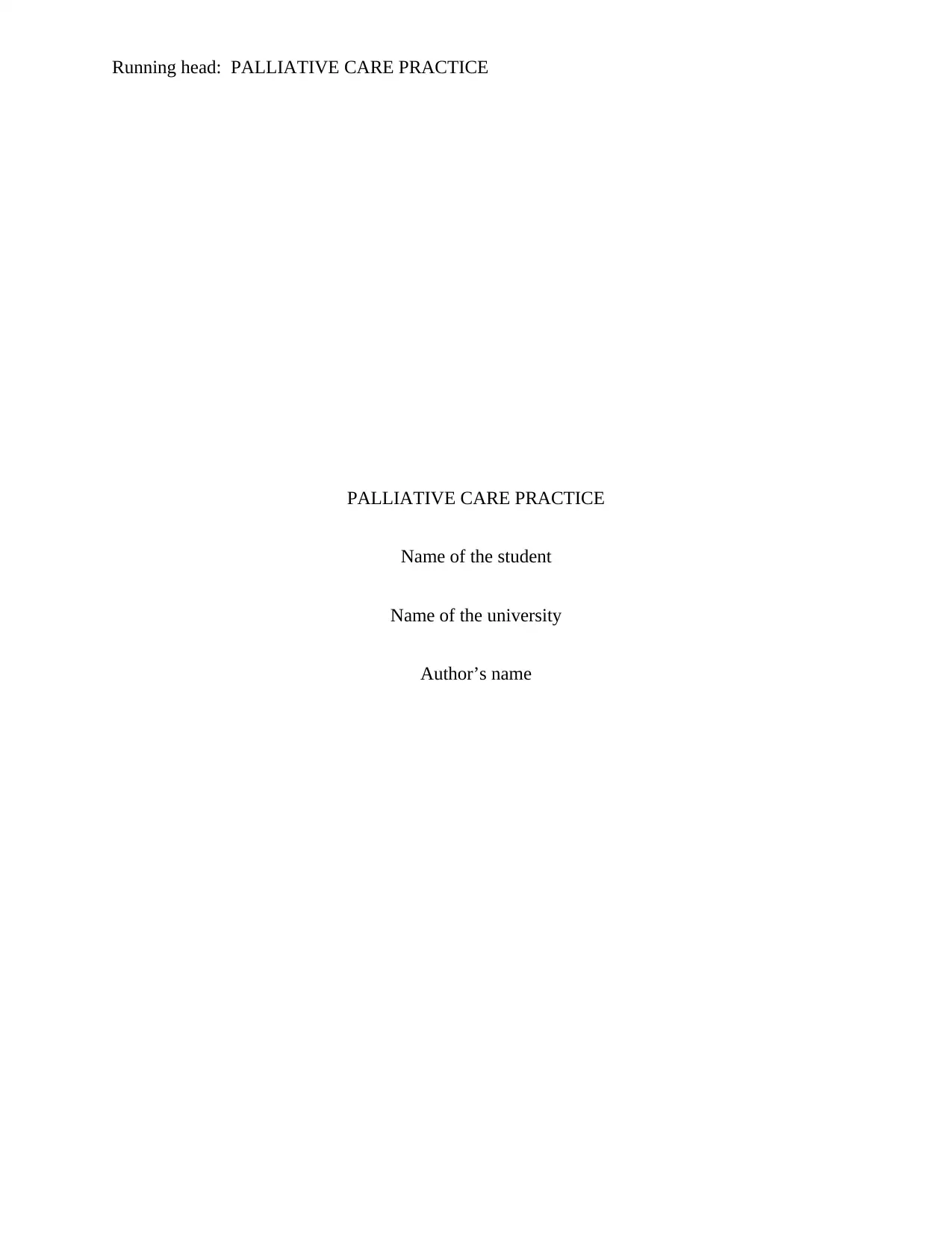
Running head: PALLIATIVE CARE PRACTICE
PALLIATIVE CARE PRACTICE
Name of the student
Name of the university
Author’s name
PALLIATIVE CARE PRACTICE
Name of the student
Name of the university
Author’s name
Secure Best Marks with AI Grader
Need help grading? Try our AI Grader for instant feedback on your assignments.
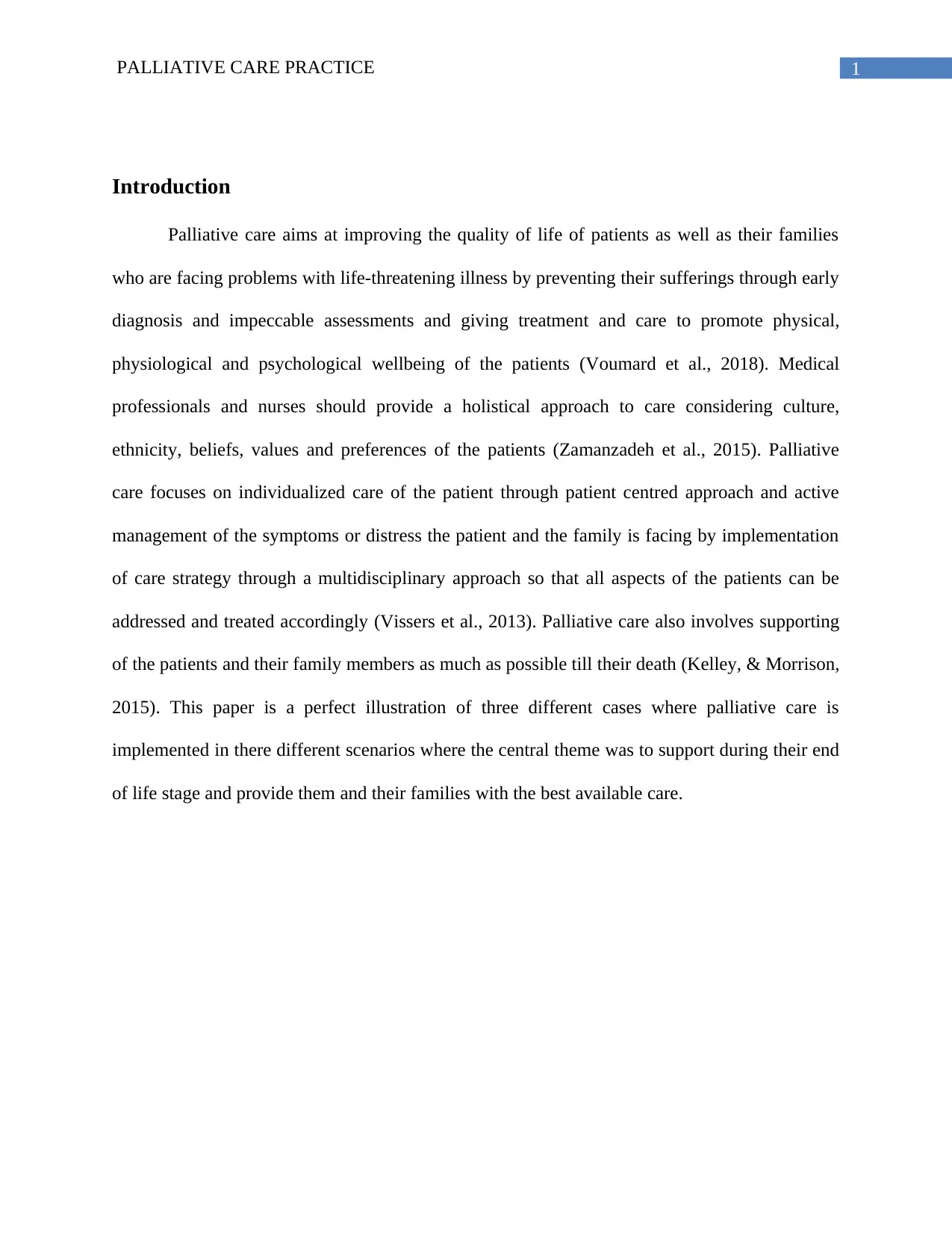
1PALLIATIVE CARE PRACTICE
Introduction
Palliative care aims at improving the quality of life of patients as well as their families
who are facing problems with life-threatening illness by preventing their sufferings through early
diagnosis and impeccable assessments and giving treatment and care to promote physical,
physiological and psychological wellbeing of the patients (Voumard et al., 2018). Medical
professionals and nurses should provide a holistical approach to care considering culture,
ethnicity, beliefs, values and preferences of the patients (Zamanzadeh et al., 2015). Palliative
care focuses on individualized care of the patient through patient centred approach and active
management of the symptoms or distress the patient and the family is facing by implementation
of care strategy through a multidisciplinary approach so that all aspects of the patients can be
addressed and treated accordingly (Vissers et al., 2013). Palliative care also involves supporting
of the patients and their family members as much as possible till their death (Kelley, & Morrison,
2015). This paper is a perfect illustration of three different cases where palliative care is
implemented in there different scenarios where the central theme was to support during their end
of life stage and provide them and their families with the best available care.
Introduction
Palliative care aims at improving the quality of life of patients as well as their families
who are facing problems with life-threatening illness by preventing their sufferings through early
diagnosis and impeccable assessments and giving treatment and care to promote physical,
physiological and psychological wellbeing of the patients (Voumard et al., 2018). Medical
professionals and nurses should provide a holistical approach to care considering culture,
ethnicity, beliefs, values and preferences of the patients (Zamanzadeh et al., 2015). Palliative
care focuses on individualized care of the patient through patient centred approach and active
management of the symptoms or distress the patient and the family is facing by implementation
of care strategy through a multidisciplinary approach so that all aspects of the patients can be
addressed and treated accordingly (Vissers et al., 2013). Palliative care also involves supporting
of the patients and their family members as much as possible till their death (Kelley, & Morrison,
2015). This paper is a perfect illustration of three different cases where palliative care is
implemented in there different scenarios where the central theme was to support during their end
of life stage and provide them and their families with the best available care.
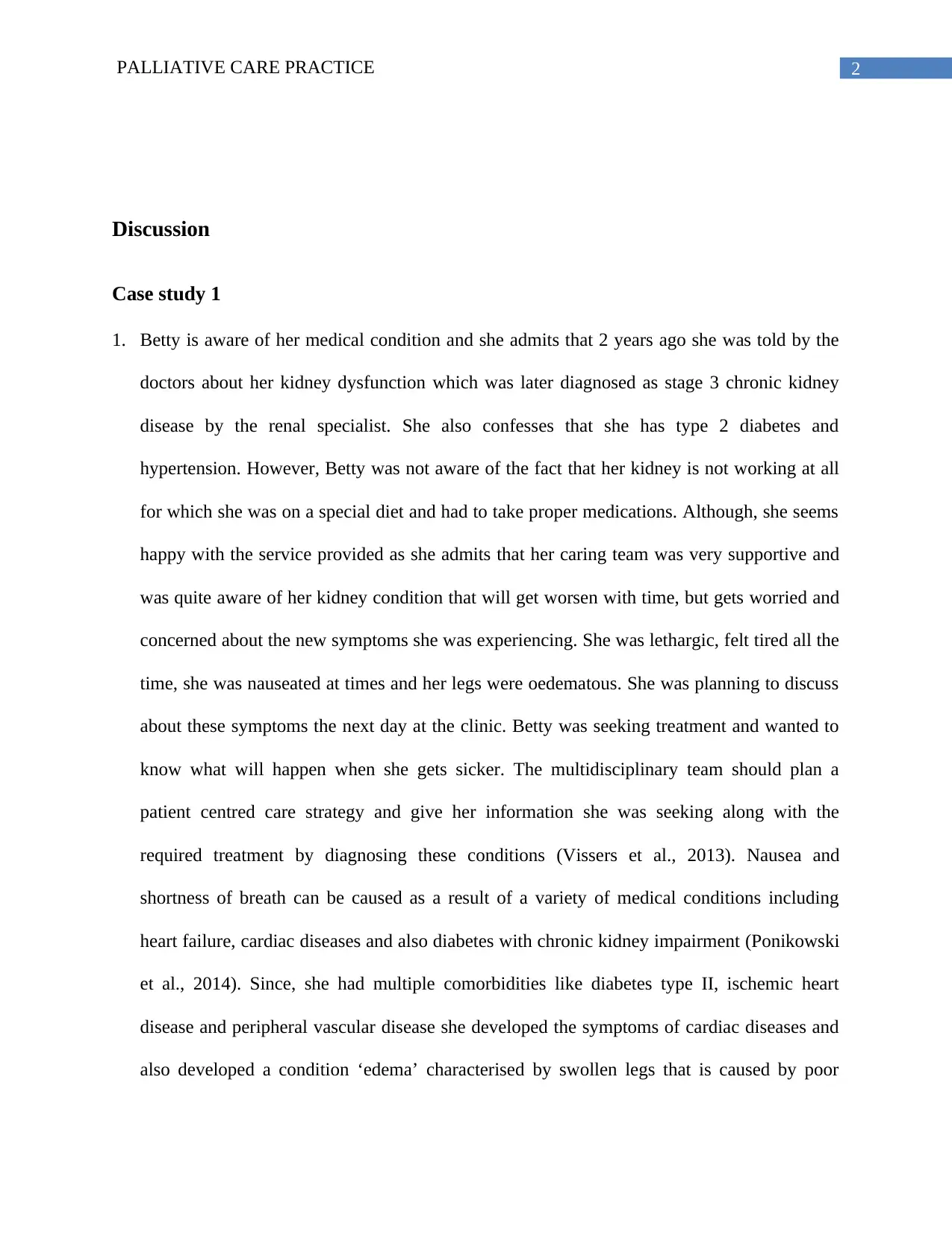
2PALLIATIVE CARE PRACTICE
Discussion
Case study 1
1. Betty is aware of her medical condition and she admits that 2 years ago she was told by the
doctors about her kidney dysfunction which was later diagnosed as stage 3 chronic kidney
disease by the renal specialist. She also confesses that she has type 2 diabetes and
hypertension. However, Betty was not aware of the fact that her kidney is not working at all
for which she was on a special diet and had to take proper medications. Although, she seems
happy with the service provided as she admits that her caring team was very supportive and
was quite aware of her kidney condition that will get worsen with time, but gets worried and
concerned about the new symptoms she was experiencing. She was lethargic, felt tired all the
time, she was nauseated at times and her legs were oedematous. She was planning to discuss
about these symptoms the next day at the clinic. Betty was seeking treatment and wanted to
know what will happen when she gets sicker. The multidisciplinary team should plan a
patient centred care strategy and give her information she was seeking along with the
required treatment by diagnosing these conditions (Vissers et al., 2013). Nausea and
shortness of breath can be caused as a result of a variety of medical conditions including
heart failure, cardiac diseases and also diabetes with chronic kidney impairment (Ponikowski
et al., 2014). Since, she had multiple comorbidities like diabetes type II, ischemic heart
disease and peripheral vascular disease she developed the symptoms of cardiac diseases and
also developed a condition ‘edema’ characterised by swollen legs that is caused by poor
Discussion
Case study 1
1. Betty is aware of her medical condition and she admits that 2 years ago she was told by the
doctors about her kidney dysfunction which was later diagnosed as stage 3 chronic kidney
disease by the renal specialist. She also confesses that she has type 2 diabetes and
hypertension. However, Betty was not aware of the fact that her kidney is not working at all
for which she was on a special diet and had to take proper medications. Although, she seems
happy with the service provided as she admits that her caring team was very supportive and
was quite aware of her kidney condition that will get worsen with time, but gets worried and
concerned about the new symptoms she was experiencing. She was lethargic, felt tired all the
time, she was nauseated at times and her legs were oedematous. She was planning to discuss
about these symptoms the next day at the clinic. Betty was seeking treatment and wanted to
know what will happen when she gets sicker. The multidisciplinary team should plan a
patient centred care strategy and give her information she was seeking along with the
required treatment by diagnosing these conditions (Vissers et al., 2013). Nausea and
shortness of breath can be caused as a result of a variety of medical conditions including
heart failure, cardiac diseases and also diabetes with chronic kidney impairment (Ponikowski
et al., 2014). Since, she had multiple comorbidities like diabetes type II, ischemic heart
disease and peripheral vascular disease she developed the symptoms of cardiac diseases and
also developed a condition ‘edema’ characterised by swollen legs that is caused by poor
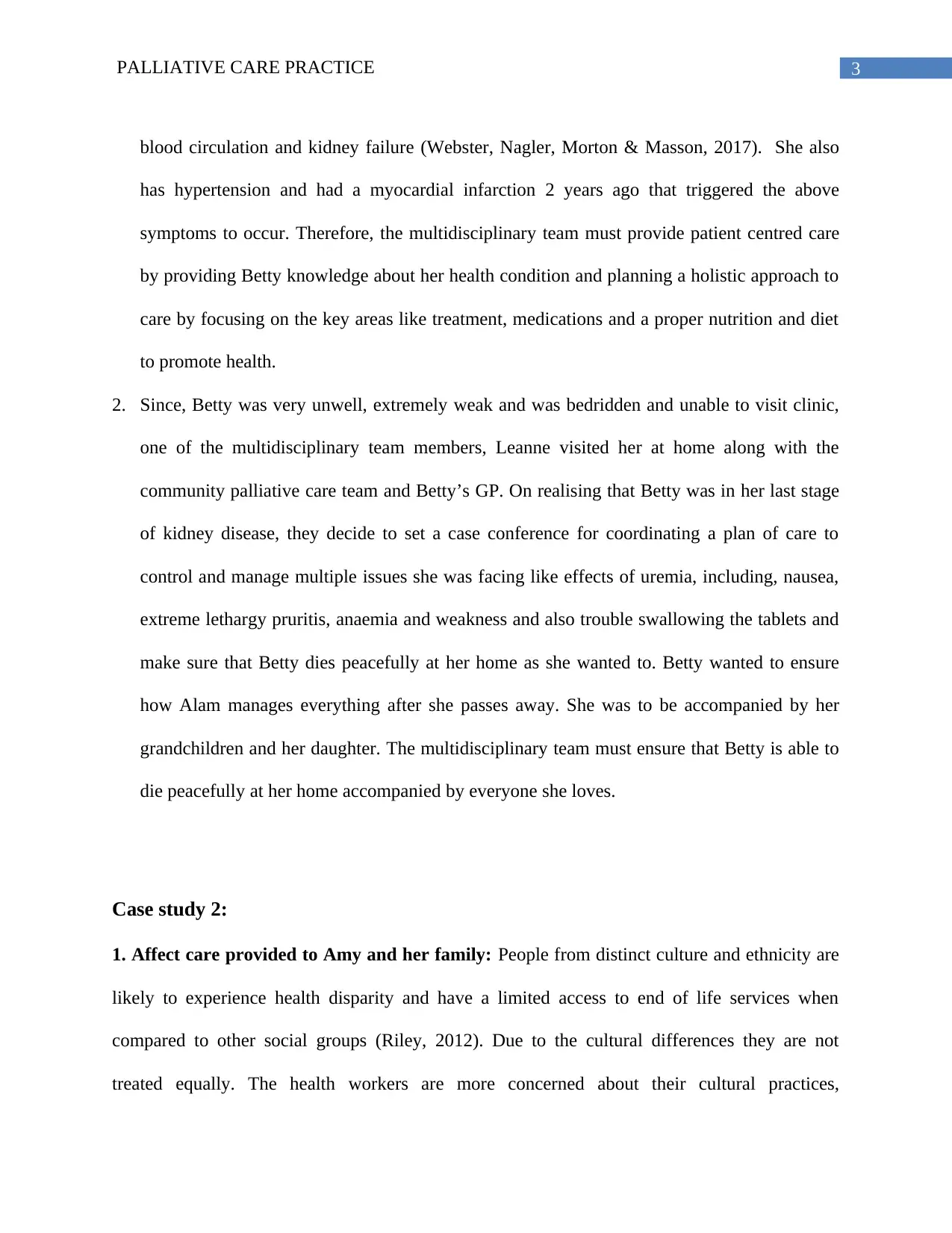
3PALLIATIVE CARE PRACTICE
blood circulation and kidney failure (Webster, Nagler, Morton & Masson, 2017). She also
has hypertension and had a myocardial infarction 2 years ago that triggered the above
symptoms to occur. Therefore, the multidisciplinary team must provide patient centred care
by providing Betty knowledge about her health condition and planning a holistic approach to
care by focusing on the key areas like treatment, medications and a proper nutrition and diet
to promote health.
2. Since, Betty was very unwell, extremely weak and was bedridden and unable to visit clinic,
one of the multidisciplinary team members, Leanne visited her at home along with the
community palliative care team and Betty’s GP. On realising that Betty was in her last stage
of kidney disease, they decide to set a case conference for coordinating a plan of care to
control and manage multiple issues she was facing like effects of uremia, including, nausea,
extreme lethargy pruritis, anaemia and weakness and also trouble swallowing the tablets and
make sure that Betty dies peacefully at her home as she wanted to. Betty wanted to ensure
how Alam manages everything after she passes away. She was to be accompanied by her
grandchildren and her daughter. The multidisciplinary team must ensure that Betty is able to
die peacefully at her home accompanied by everyone she loves.
Case study 2:
1. Affect care provided to Amy and her family: People from distinct culture and ethnicity are
likely to experience health disparity and have a limited access to end of life services when
compared to other social groups (Riley, 2012). Due to the cultural differences they are not
treated equally. The health workers are more concerned about their cultural practices,
blood circulation and kidney failure (Webster, Nagler, Morton & Masson, 2017). She also
has hypertension and had a myocardial infarction 2 years ago that triggered the above
symptoms to occur. Therefore, the multidisciplinary team must provide patient centred care
by providing Betty knowledge about her health condition and planning a holistic approach to
care by focusing on the key areas like treatment, medications and a proper nutrition and diet
to promote health.
2. Since, Betty was very unwell, extremely weak and was bedridden and unable to visit clinic,
one of the multidisciplinary team members, Leanne visited her at home along with the
community palliative care team and Betty’s GP. On realising that Betty was in her last stage
of kidney disease, they decide to set a case conference for coordinating a plan of care to
control and manage multiple issues she was facing like effects of uremia, including, nausea,
extreme lethargy pruritis, anaemia and weakness and also trouble swallowing the tablets and
make sure that Betty dies peacefully at her home as she wanted to. Betty wanted to ensure
how Alam manages everything after she passes away. She was to be accompanied by her
grandchildren and her daughter. The multidisciplinary team must ensure that Betty is able to
die peacefully at her home accompanied by everyone she loves.
Case study 2:
1. Affect care provided to Amy and her family: People from distinct culture and ethnicity are
likely to experience health disparity and have a limited access to end of life services when
compared to other social groups (Riley, 2012). Due to the cultural differences they are not
treated equally. The health workers are more concerned about their cultural practices,
Secure Best Marks with AI Grader
Need help grading? Try our AI Grader for instant feedback on your assignments.
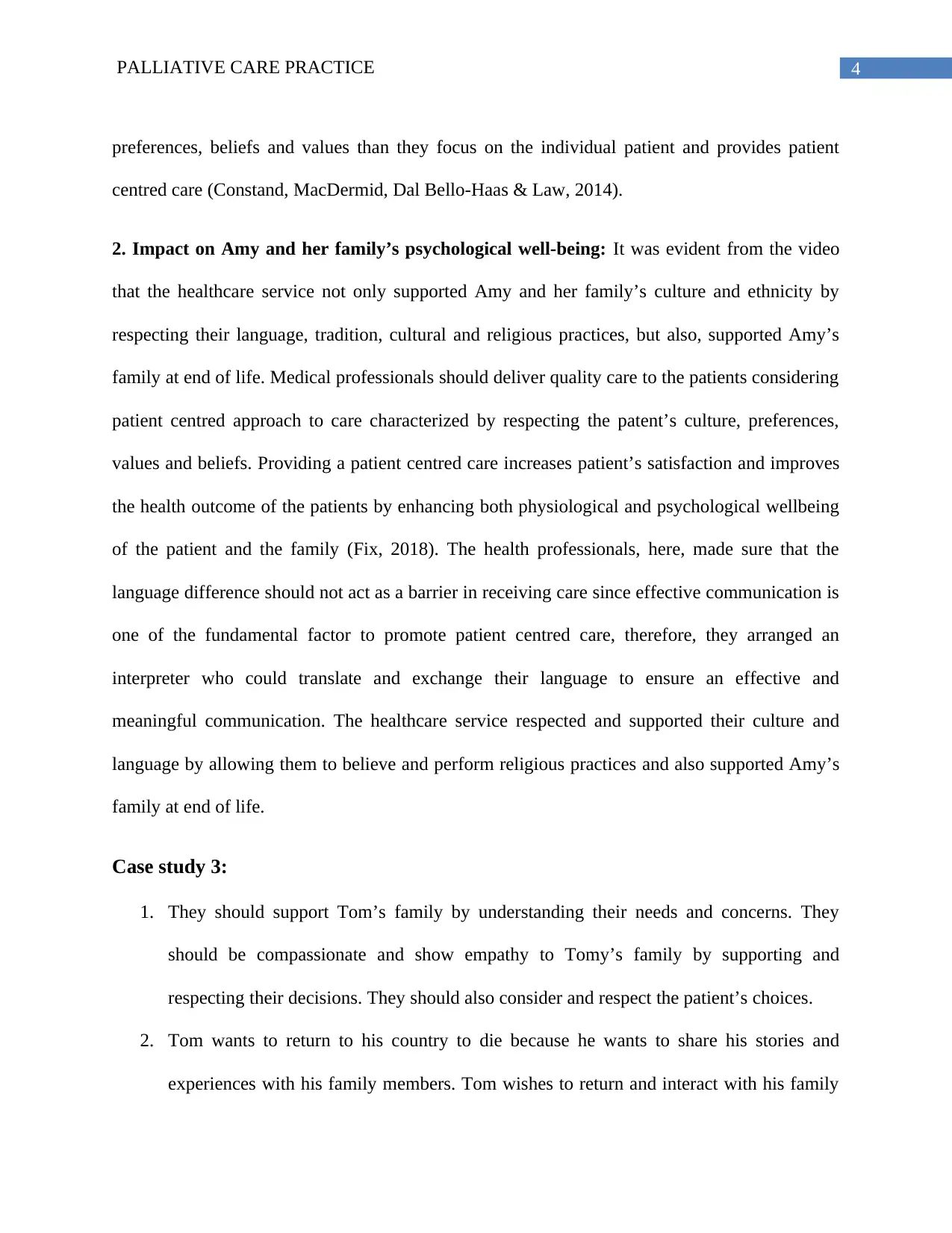
4PALLIATIVE CARE PRACTICE
preferences, beliefs and values than they focus on the individual patient and provides patient
centred care (Constand, MacDermid, Dal Bello-Haas & Law, 2014).
2. Impact on Amy and her family’s psychological well-being: It was evident from the video
that the healthcare service not only supported Amy and her family’s culture and ethnicity by
respecting their language, tradition, cultural and religious practices, but also, supported Amy’s
family at end of life. Medical professionals should deliver quality care to the patients considering
patient centred approach to care characterized by respecting the patent’s culture, preferences,
values and beliefs. Providing a patient centred care increases patient’s satisfaction and improves
the health outcome of the patients by enhancing both physiological and psychological wellbeing
of the patient and the family (Fix, 2018). The health professionals, here, made sure that the
language difference should not act as a barrier in receiving care since effective communication is
one of the fundamental factor to promote patient centred care, therefore, they arranged an
interpreter who could translate and exchange their language to ensure an effective and
meaningful communication. The healthcare service respected and supported their culture and
language by allowing them to believe and perform religious practices and also supported Amy’s
family at end of life.
Case study 3:
1. They should support Tom’s family by understanding their needs and concerns. They
should be compassionate and show empathy to Tomy’s family by supporting and
respecting their decisions. They should also consider and respect the patient’s choices.
2. Tom wants to return to his country to die because he wants to share his stories and
experiences with his family members. Tom wishes to return and interact with his family
preferences, beliefs and values than they focus on the individual patient and provides patient
centred care (Constand, MacDermid, Dal Bello-Haas & Law, 2014).
2. Impact on Amy and her family’s psychological well-being: It was evident from the video
that the healthcare service not only supported Amy and her family’s culture and ethnicity by
respecting their language, tradition, cultural and religious practices, but also, supported Amy’s
family at end of life. Medical professionals should deliver quality care to the patients considering
patient centred approach to care characterized by respecting the patent’s culture, preferences,
values and beliefs. Providing a patient centred care increases patient’s satisfaction and improves
the health outcome of the patients by enhancing both physiological and psychological wellbeing
of the patient and the family (Fix, 2018). The health professionals, here, made sure that the
language difference should not act as a barrier in receiving care since effective communication is
one of the fundamental factor to promote patient centred care, therefore, they arranged an
interpreter who could translate and exchange their language to ensure an effective and
meaningful communication. The healthcare service respected and supported their culture and
language by allowing them to believe and perform religious practices and also supported Amy’s
family at end of life.
Case study 3:
1. They should support Tom’s family by understanding their needs and concerns. They
should be compassionate and show empathy to Tomy’s family by supporting and
respecting their decisions. They should also consider and respect the patient’s choices.
2. Tom wants to return to his country to die because he wants to share his stories and
experiences with his family members. Tom wishes to return and interact with his family
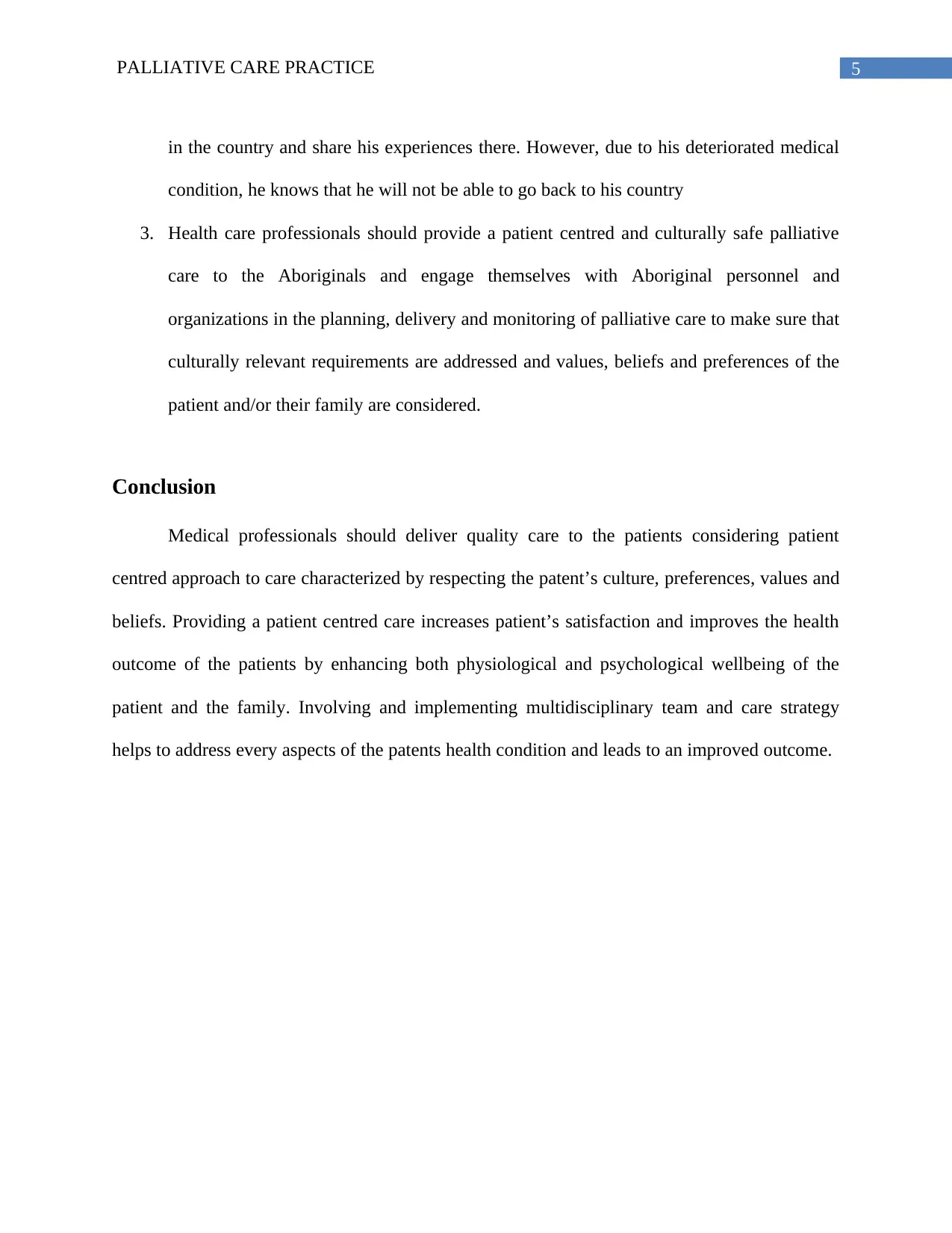
5PALLIATIVE CARE PRACTICE
in the country and share his experiences there. However, due to his deteriorated medical
condition, he knows that he will not be able to go back to his country
3. Health care professionals should provide a patient centred and culturally safe palliative
care to the Aboriginals and engage themselves with Aboriginal personnel and
organizations in the planning, delivery and monitoring of palliative care to make sure that
culturally relevant requirements are addressed and values, beliefs and preferences of the
patient and/or their family are considered.
Conclusion
Medical professionals should deliver quality care to the patients considering patient
centred approach to care characterized by respecting the patent’s culture, preferences, values and
beliefs. Providing a patient centred care increases patient’s satisfaction and improves the health
outcome of the patients by enhancing both physiological and psychological wellbeing of the
patient and the family. Involving and implementing multidisciplinary team and care strategy
helps to address every aspects of the patents health condition and leads to an improved outcome.
in the country and share his experiences there. However, due to his deteriorated medical
condition, he knows that he will not be able to go back to his country
3. Health care professionals should provide a patient centred and culturally safe palliative
care to the Aboriginals and engage themselves with Aboriginal personnel and
organizations in the planning, delivery and monitoring of palliative care to make sure that
culturally relevant requirements are addressed and values, beliefs and preferences of the
patient and/or their family are considered.
Conclusion
Medical professionals should deliver quality care to the patients considering patient
centred approach to care characterized by respecting the patent’s culture, preferences, values and
beliefs. Providing a patient centred care increases patient’s satisfaction and improves the health
outcome of the patients by enhancing both physiological and psychological wellbeing of the
patient and the family. Involving and implementing multidisciplinary team and care strategy
helps to address every aspects of the patents health condition and leads to an improved outcome.
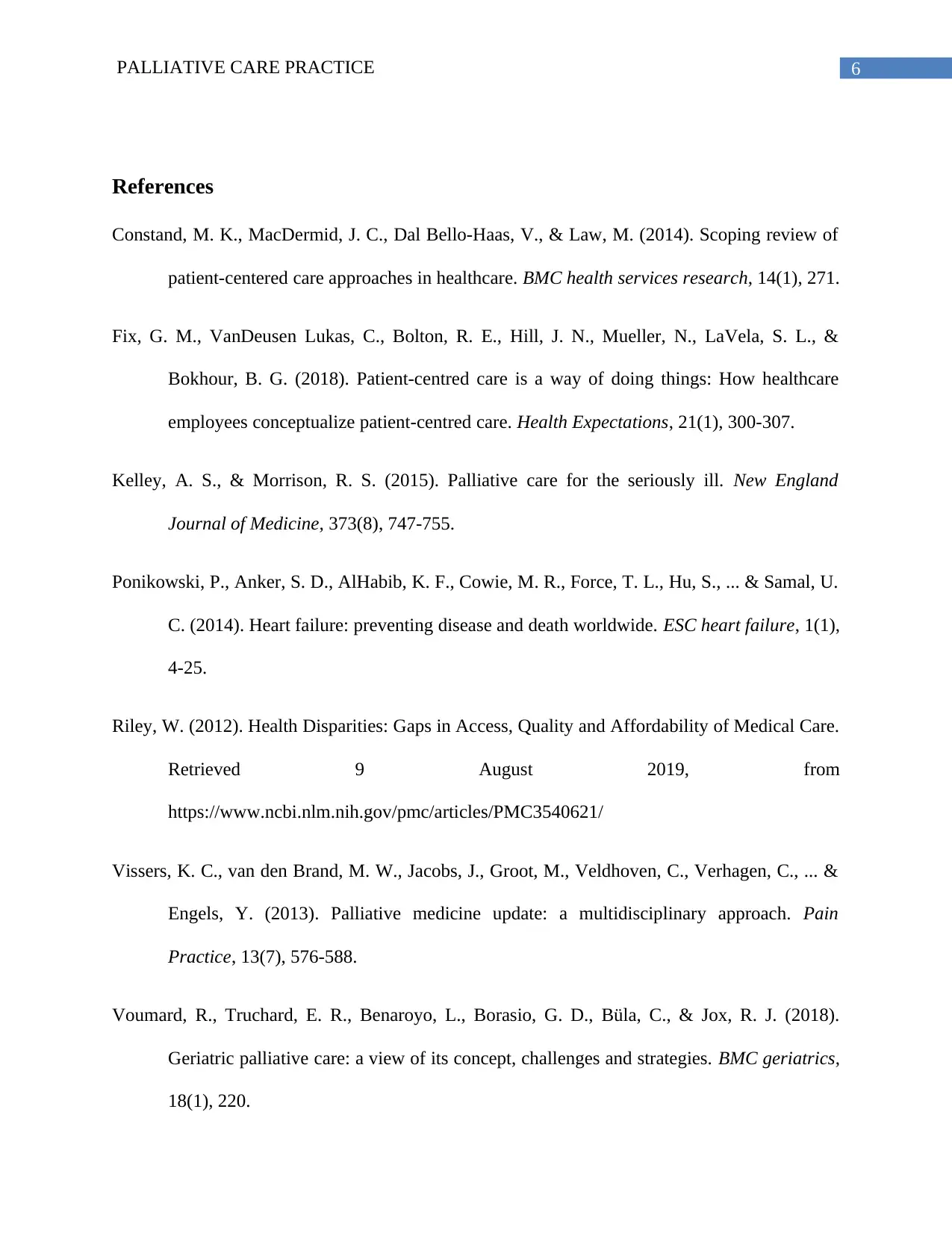
6PALLIATIVE CARE PRACTICE
References
Constand, M. K., MacDermid, J. C., Dal Bello-Haas, V., & Law, M. (2014). Scoping review of
patient-centered care approaches in healthcare. BMC health services research, 14(1), 271.
Fix, G. M., VanDeusen Lukas, C., Bolton, R. E., Hill, J. N., Mueller, N., LaVela, S. L., &
Bokhour, B. G. (2018). Patient‐centred care is a way of doing things: How healthcare
employees conceptualize patient‐centred care. Health Expectations, 21(1), 300-307.
Kelley, A. S., & Morrison, R. S. (2015). Palliative care for the seriously ill. New England
Journal of Medicine, 373(8), 747-755.
Ponikowski, P., Anker, S. D., AlHabib, K. F., Cowie, M. R., Force, T. L., Hu, S., ... & Samal, U.
C. (2014). Heart failure: preventing disease and death worldwide. ESC heart failure, 1(1),
4-25.
Riley, W. (2012). Health Disparities: Gaps in Access, Quality and Affordability of Medical Care.
Retrieved 9 August 2019, from
https://www.ncbi.nlm.nih.gov/pmc/articles/PMC3540621/
Vissers, K. C., van den Brand, M. W., Jacobs, J., Groot, M., Veldhoven, C., Verhagen, C., ... &
Engels, Y. (2013). Palliative medicine update: a multidisciplinary approach. Pain
Practice, 13(7), 576-588.
Voumard, R., Truchard, E. R., Benaroyo, L., Borasio, G. D., Büla, C., & Jox, R. J. (2018).
Geriatric palliative care: a view of its concept, challenges and strategies. BMC geriatrics,
18(1), 220.
References
Constand, M. K., MacDermid, J. C., Dal Bello-Haas, V., & Law, M. (2014). Scoping review of
patient-centered care approaches in healthcare. BMC health services research, 14(1), 271.
Fix, G. M., VanDeusen Lukas, C., Bolton, R. E., Hill, J. N., Mueller, N., LaVela, S. L., &
Bokhour, B. G. (2018). Patient‐centred care is a way of doing things: How healthcare
employees conceptualize patient‐centred care. Health Expectations, 21(1), 300-307.
Kelley, A. S., & Morrison, R. S. (2015). Palliative care for the seriously ill. New England
Journal of Medicine, 373(8), 747-755.
Ponikowski, P., Anker, S. D., AlHabib, K. F., Cowie, M. R., Force, T. L., Hu, S., ... & Samal, U.
C. (2014). Heart failure: preventing disease and death worldwide. ESC heart failure, 1(1),
4-25.
Riley, W. (2012). Health Disparities: Gaps in Access, Quality and Affordability of Medical Care.
Retrieved 9 August 2019, from
https://www.ncbi.nlm.nih.gov/pmc/articles/PMC3540621/
Vissers, K. C., van den Brand, M. W., Jacobs, J., Groot, M., Veldhoven, C., Verhagen, C., ... &
Engels, Y. (2013). Palliative medicine update: a multidisciplinary approach. Pain
Practice, 13(7), 576-588.
Voumard, R., Truchard, E. R., Benaroyo, L., Borasio, G. D., Büla, C., & Jox, R. J. (2018).
Geriatric palliative care: a view of its concept, challenges and strategies. BMC geriatrics,
18(1), 220.
Paraphrase This Document
Need a fresh take? Get an instant paraphrase of this document with our AI Paraphraser
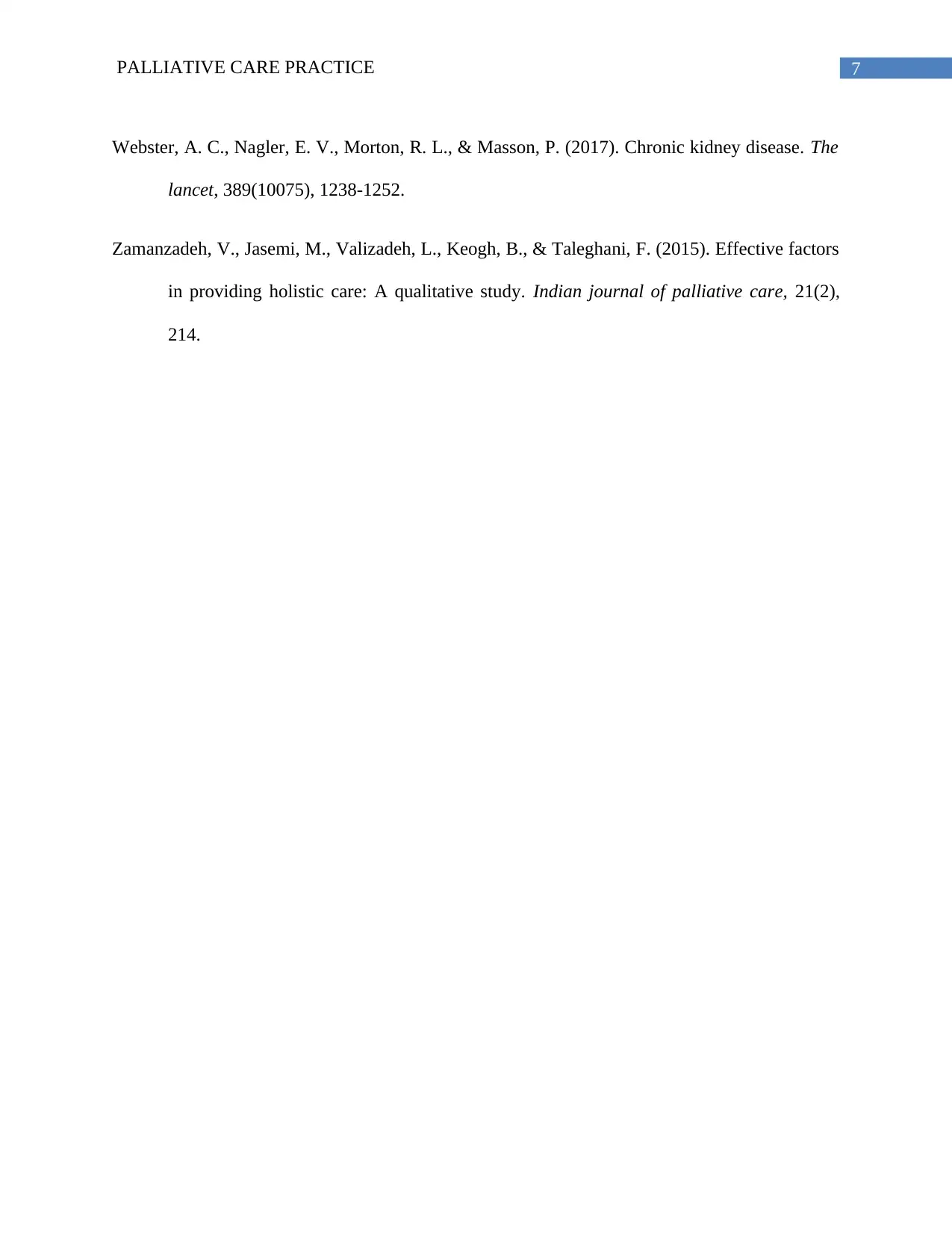
7PALLIATIVE CARE PRACTICE
Webster, A. C., Nagler, E. V., Morton, R. L., & Masson, P. (2017). Chronic kidney disease. The
lancet, 389(10075), 1238-1252.
Zamanzadeh, V., Jasemi, M., Valizadeh, L., Keogh, B., & Taleghani, F. (2015). Effective factors
in providing holistic care: A qualitative study. Indian journal of palliative care, 21(2),
214.
Webster, A. C., Nagler, E. V., Morton, R. L., & Masson, P. (2017). Chronic kidney disease. The
lancet, 389(10075), 1238-1252.
Zamanzadeh, V., Jasemi, M., Valizadeh, L., Keogh, B., & Taleghani, F. (2015). Effective factors
in providing holistic care: A qualitative study. Indian journal of palliative care, 21(2),
214.
1 out of 8
Related Documents
Your All-in-One AI-Powered Toolkit for Academic Success.
+13062052269
info@desklib.com
Available 24*7 on WhatsApp / Email
![[object Object]](/_next/static/media/star-bottom.7253800d.svg)
Unlock your academic potential
© 2024 | Zucol Services PVT LTD | All rights reserved.





